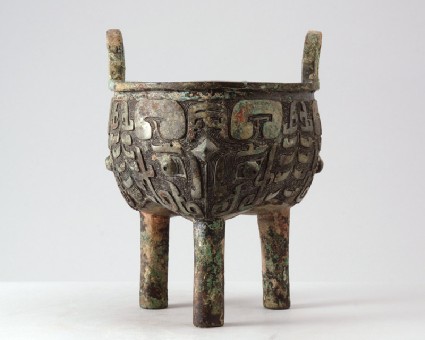Browse: 2530 objects
Ritual food vessel, or ding, with taotie mask pattern
- loan
-
Details
- Associated place
- Date
-
12th - 11th century BC (1200 - 1001 BC)
Shang Dynasty (c. 1600 - c. 1050 BC)
- Material and technique
- bronze
- Dimensions
- 23.3 x 18.2 x 18 cm (height x width x depth)
- Material index
-
processed material › metal › alloy › copper alloy › bronze
- Technique index
- Object type index
- No. of items
- 1
- Credit line
- Lent by the Sir Alan Barlow Collection Trust.
- Accession no.
- LI1301.2
-
Further reading
University of Sussex, and Arts and Humanities Research Council, The Barlow Collection, supervised by Regina Krahl, Maurice Howard, and Aiden Leeves (Sussex: University of Sussex, 2006), no. B2
Glossary (2)
ding, taotie
-
ding
A Chinese bronze tripod ritual cooking vessel. Also a type of white porcelain from Northern China.
-
taotie
Stylized monster mask decoration with prominent eyes and scrolling horns. The motif has been known since the 1100s. Its significance remains mysterious.
Location
-
- currently in research collection
Objects are sometimes moved to a different location. Our object location data is usually updated on a monthly basis. Contact the Jameel Study Centre if you are planning to visit the museum to see a particular object on display, or would like to arrange an appointment to see an object in our reserve collections.
Publications online
-

The Barlow Collection
The wide rounded bowl is slightly lobed and pointed towards three tall columnar legs. The rim has an everted angular flange and two high arched handles. The bowl is decorated with an impressive relief design of three formal animal masks (taotie), each centred on one leg, with a diamond-shaped boss on the forehead and eyes in high relief, and eyebrows, curved horns, muzzle and further curled features symmetrically arranged, all in low relief on a dense leiwen (‘thunder pattern’) ground of scrollwork. The patina is of greenish tone, with the recesses of the design probably deliberately filled in in black, to make the design stand out more clearly. An eight-character inscription is cast inside the vessel, beginning with a clan sign in form of a man in side view, followed by the characters zuo fu gui bao zun yi [made father gui’s precious sacrificial vessel], and followed by another clan sign in form of a man holding up a child.
© 2013 University of Oxford - Ashmolean Museum





